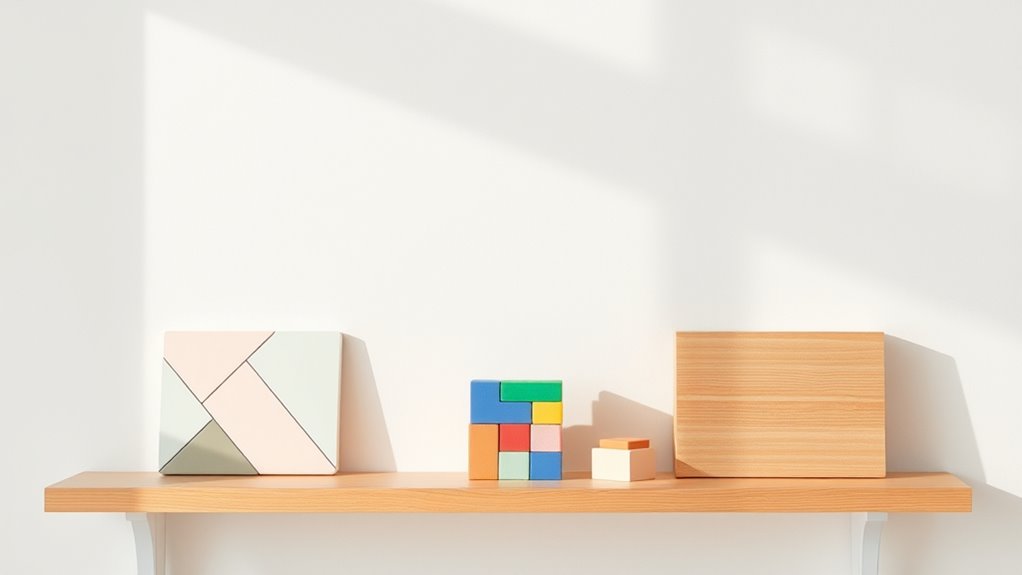When choosing minimalist gifts for kids that focus on skill-building, opt for experiences like museum visits or outdoor adventures that foster learning and bonding. Open-ended toys such as building sets, art supplies, or dress-up clothes inspire creativity and problem-solving. Practical clothes, musical instruments, and age-appropriate educational kits support skill development. Engaging in family outings or subscribing to ongoing courses nurtures long-term interests. Keep it simple and meaningful—there’s more to discover if you keep exploring.
Key Takeaways
- Choose open-ended toys like building blocks and art supplies that promote creativity, problem-solving, and long-term skill development.
- Opt for experience-based gifts such as museum visits or classes that foster learning and memorable moments over material possessions.
- Select sustainable, versatile clothing and practical accessories designed for durability and ease, reducing clutter and encouraging independence.
- Incorporate age-appropriate, skill-building toys like sensory or pretend play items that support early motor and social development.
- Prioritize subscriptions or courses that offer ongoing STEM, arts, or craft projects to deepen engagement and nurture long-term interests.
Emphasizing Learning Through Experience and Skills
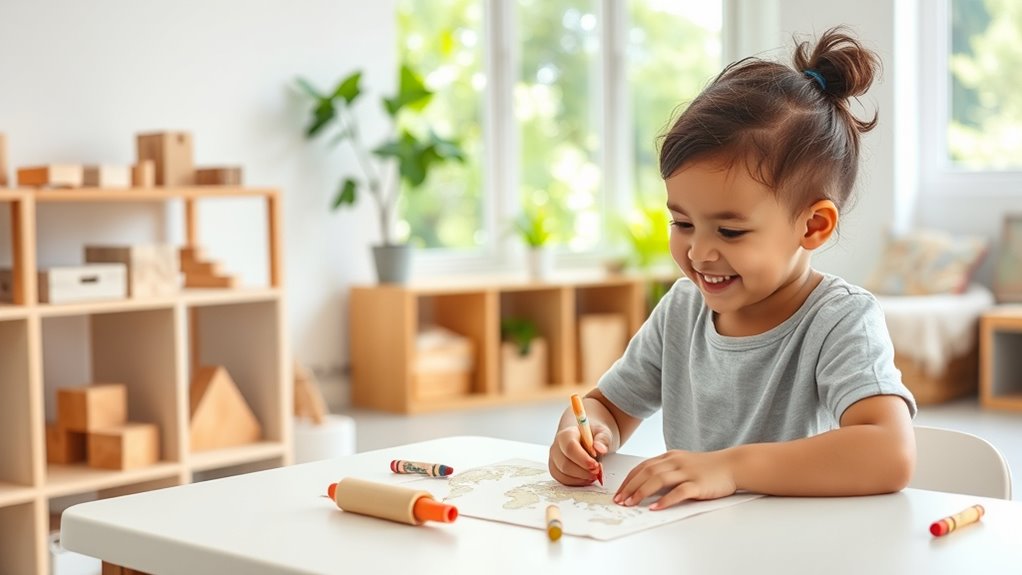
Focusing on learning through experience and skill-building offers children meaningful opportunities to grow. Experience gifts, like trips to museums or zoos, boost cognitive development by exposing kids to new environments and ideas. These adventures promote gratitude and strengthen emotional bonds, as shared moments create lasting memories. Unlike material possessions, experiences foster appreciation and emotional maturity, shaping a child’s worldview. Additionally, engaging in skill-building activities such as sports or arts enhances abilities, boosts confidence, and encourages social interaction. These activities are often personalized, catering to your child’s interests and learning style, which keeps them motivated and involved. Incorporating mental wellbeing practices into these experiences can further support emotional resilience and overall development. Overall, emphasizing experiences and skills nurtures well-rounded development, creating meaningful, long-lasting impacts that go far beyond temporary toys or possessions.
Choosing Open-Ended Toys That Inspire Creativity
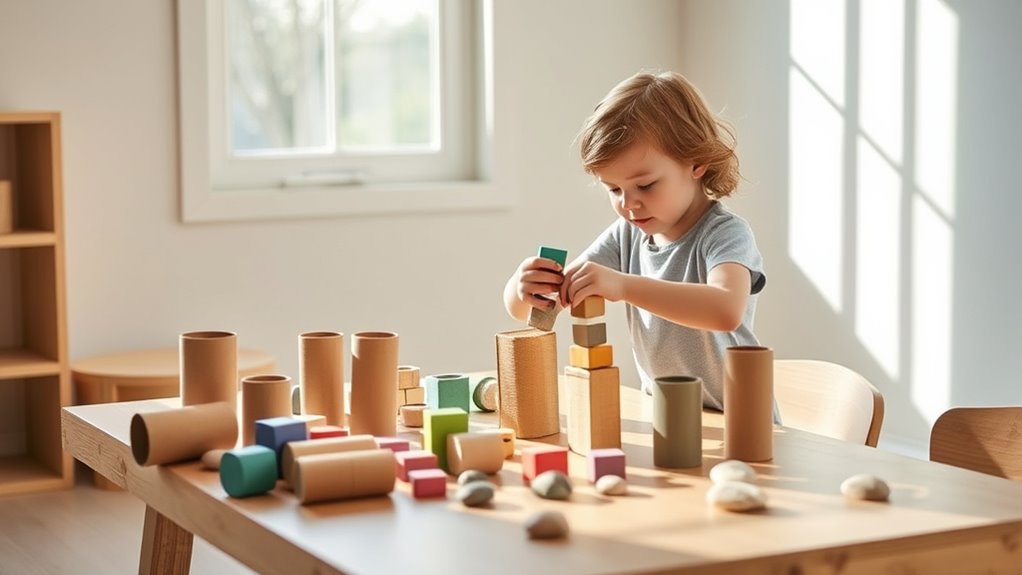
Open-ended toys give kids versatile play opportunities that foster imagination. When you choose these kinds of toys, children can explore different ideas and invent new ways to play. This openness encourages creative thinking and keeps them engaged for longer periods. Scientific research also confirms that such toys ignite imagination and creativity, helping children develop essential skills for their future. Additionally, Ford Tuning techniques can serve as an example of how customized, creative approaches enhance performance and engagement in various activities.
Versatile Play Opportunities
Choosing toys that encourage creativity doesn’t mean you have to opt for complicated or expensive options. Open-ended toys like LEGO bricks and building blocks offer endless play possibilities, helping children develop problem-solving, critical thinking, and adaptability. These toys promote cognitive growth by challenging kids to create and rebuild, fostering flexible thinking. They also encourage collaboration and communication when children work together. Outdoor exploration kits and art supplies provide versatile options for physical activity and emotional expression, supporting motor skills and emotional regulation. Toys that encourage experimentation, such as science sets, spark curiosity and exploration. The beauty of open-ended toys lies in their ability to grow with your child, offering varied opportunities for skill-building while remaining simple, engaging, and minimalist in design. Open-ended play has been a natural form of play throughout human history, now with a formal name. Incorporating developmentally appropriate toys can further enhance a child’s learning experiences and ensure safe, meaningful play.
Encourages Imaginative Exploration
Encouraging imaginative exploration begins with selecting toys that inspire creativity and allow children to invent their own worlds. Open-ended toys, like building sets, art supplies, and dress-up clothes, foster creativity by offering endless ways to play. They help children develop problem-solving skills and critical thinking as they experiment and create. These toys also promote social interaction, encouraging kids to collaborate and improvise during pretend scenarios. Simple, versatile, and often made from natural or sustainable materials, open-ended toys support expressive storytelling and role-playing. By choosing such toys, you give your child tools to explore their imagination, build confidence, and develop essential skills that benefit them long-term. Research shows that children engaging with open-ended toys tend to develop better cognitive and social abilities while having more fun during play. These gifts turn playtime into a meaningful, skill-building experience.
Practical Clothing and Accessories for Daily Use

When choosing practical clothing and accessories, focus on items that combine durability with comfort to keep up with active kids. Age-appropriate styles guarantee that outfits are both functional and suitable for their developmental stage. By selecting simple, versatile pieces, you can create a wardrobe that’s easy to care for and long-lasting. The emphasis on eco-friendly materials further supports sustainable consumption and aligns with minimalist principles. Incorporating best laundry detergents that are gentle yet effective ensures clothes stay in good condition over time.
Durability and Comfort
Durability and comfort are essential considerations when selecting practical clothing and accessories for kids, especially for daily use. You want garments that withstand frequent washing and active play while keeping your child comfortable throughout the day. Cotton is the top choice for many parents because of its softness, resistance to fading, and breathability. Organic options like organic cotton and bamboo are popular for sensitive skin and non-toxicity. Features such as elastic waistbands and reinforced seams boost longevity and comfort. It’s also important to avoid synthetic fibers linked to health concerns. Look for clothes that are easy to wash, resist shrinking and fading, and incorporate stain-resistant or adjustable elements. These qualities assure your child’s clothes stay functional and comfortable, supporting active days and repeated wear without sacrificing quality. Market data indicates that parents prefer cotton for its durability and natural qualities, making it a consistent choice for everyday kids’ apparel. Additionally, selecting high-quality fabrics with proven resilience can further extend the lifespan of children’s clothing, ensuring they remain in good condition even with frequent use.
Age-Appropriate Styles
Choosing age-appropriate clothing and accessories for daily use helps your child stay comfortable, independent, and well-prepared for their activities. A minimalist wardrobe typically includes enough clothing for about two weeks, reducing laundry stress. For kids aged 3 to 6, this might mean 6-7 dresses with leggings, 7 shirts, and 7 pants for girls, and 10 pants with 14 shirts for boys. Seasonal rotation guarantees only current-sized and seasonally appropriate items are accessible, while outgrown clothes are stored separately. Simple styles like leggings, basic shirts, and versatile dresses allow easy mixing and matching. Minimal accessories, like socks, tights, and functional footwear such as rain boots or snow shoes, support outdoor play and independence. Organized, accessible storage fosters your child’s confidence in dressing themselves. Regularly assessing and rotating clothing ensures your child’s wardrobe remains practical and clutter-free, supporting their growing independence and comfort. Incorporating clothing organization strategies can further streamline dressing routines and help maintain a tidy space.
Cultivating Creativity With Art and Writing Supplies

Using art and writing supplies encourages children to explore their imagination and develop their creative thinking skills. When kids choose colors, techniques, or materials, they practice critical thinking and decision-making. Creating art also boosts problem-solving as they evaluate different approaches and outcomes. Drawing, painting, and sculpting help improve spatial reasoning, essential for understanding shapes and dimensions. Planning artwork before starting exercises executive functions like goal setting and organization. Additionally, artistic activities reinforce understanding of patterns, cause and effect, and comparisons, which support math skills.
- Select and combine colors to express ideas
- Experiment with different techniques and materials
- Evaluate and refine their projects
- Plan and execute complex compositions
- Connect visual patterns with mathematical concepts
Supporting Musical Growth With Lessons and Instruments
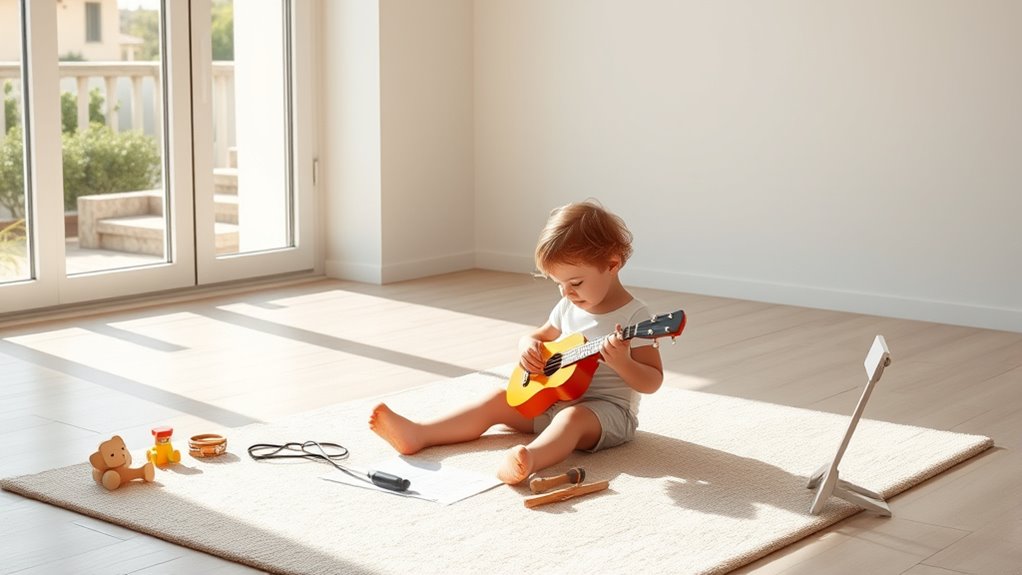
Encouraging musical growth in children involves more than just providing instruments; it requires engaging them in structured lessons and meaningful practice. Factors like training intensity, family support, and cultural background influence their development. Music training can improve skills like tonal discrimination and may boost language and executive functions. Neurological studies show that practicing music increases gray matter in auditory areas and alters cortical thickness. Environmental factors play a significant role, often more than genetics, in fostering musical engagement. Selecting the right instrument is key—consider accessibility, cost, portability, and age appropriateness. Programs like community initiatives or school-based lessons can enhance skills and social connections. Incorporating predictive modeling into educational strategies can help tailor instruction to individual student needs, further supporting their musical and cognitive development. Supporting your child’s musical journey with lessons and suitable instruments helps build confidence and cognitive abilities over time.
Encouraging Critical Thinking With Puzzles and Escape Rooms
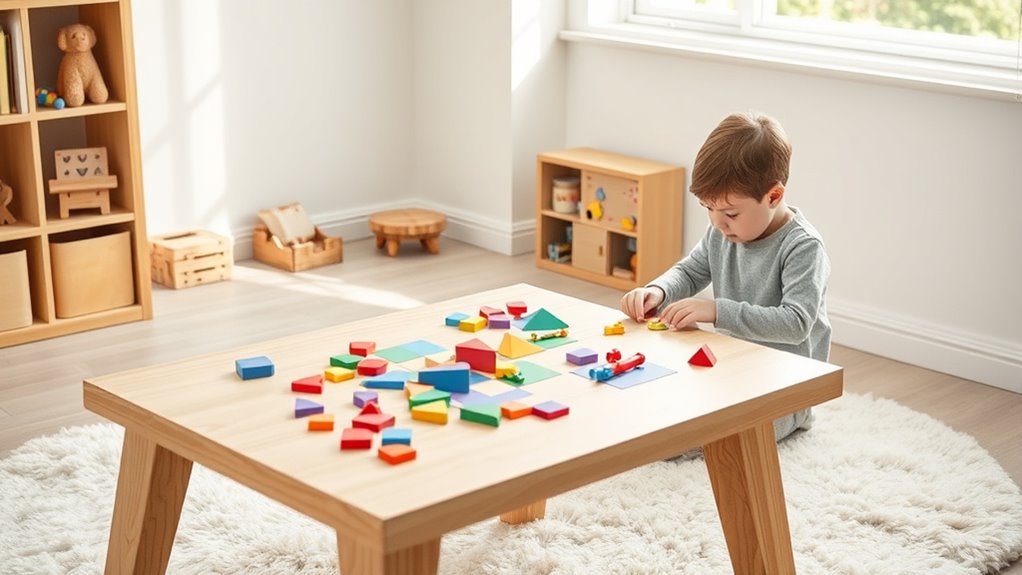
Despite the decline in critical thinking skills among children, engaging them with puzzles and escape rooms offers a powerful way to reverse this trend. These activities demand analysis, logic, and creative problem-solving, helping kids develop deeper understanding and reasoning. Working together fosters teamwork and communication, essential skills for real-world success. Plus, they encourage kids to ask questions, explore multiple solutions, and justify their choices. To maximize benefits, provide open-ended puzzles with no single answer, promote discussion, and create opportunities for trial and error. Introducing increasingly complex challenges keeps kids motivated and stimulates growth. Incorporating these activities into your offerings not only builds critical thinking but also makes learning engaging and memorable. They’re simple, effective tools that support essential skill development in a fun, minimalist way. Fathers’ influence can also serve as a motivating example that inspires children to develop their own problem-solving abilities.
Creating Memorable Family Activities and Outings
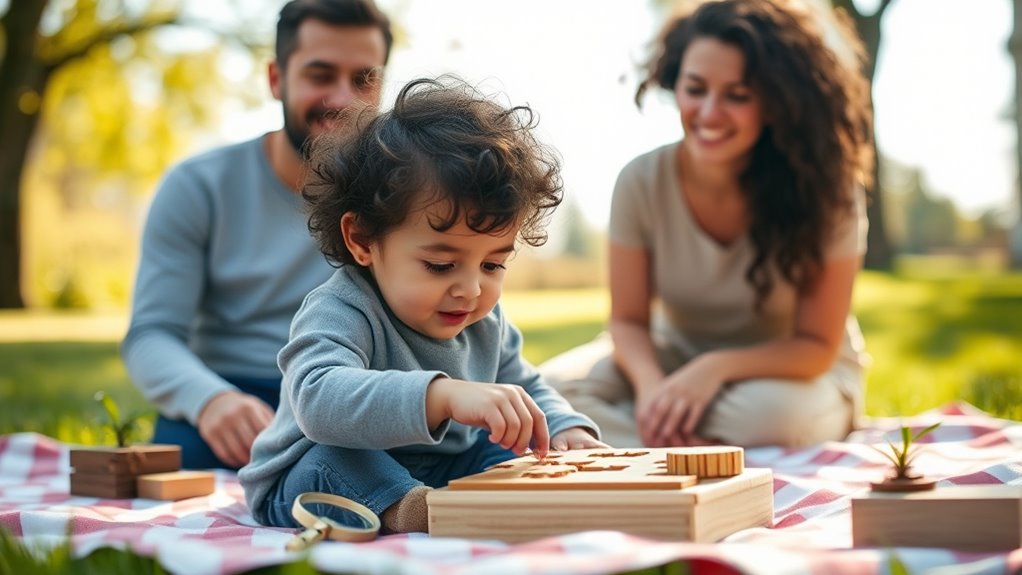
You can create memorable family moments without spending much by exploring affordable local adventures like parks, trails, or community events. Seasonal outings, such as autumn leaf-peeping or winter snowball fights, add variety and excitement throughout the year. These simple experiences strengthen bonds while keeping things fun and budget-friendly. Outdoor activities like hiking or biking also promote physical health and mental well-being, making your family time even more enriching. Additionally, engaging in cruise-related activities can inspire curiosity and learning among children, even during stay-at-home periods.
Affordable Local Adventures
Affordable local adventures offer families a meaningful way to create lasting memories without stretching their budgets. By exploring nearby parks, museums, and community events, you can foster learning and connection without costly expenses. Local resources like community websites and libraries keep you informed about budget-friendly activities suited for your kids’ ages. Parks and recreation departments often offer inexpensive programs and day camps that build skills and encourage outdoor play. Visiting historic sites or attending free community workshops can spark curiosity and creativity. Using review platforms helps you find affordable venues with positive experiences. These outings promote family bonding, reduce financial stress, and support sustainable habits. Plus, proximity and flexible schedules make frequent, enriching experiences easy and accessible. Researching outdoor activities that incorporate nature trails or water features can enhance the educational value of your adventures.
Seasonal Family Excursions
Seasonal family excursions turn everyday outings into memorable adventures that align with the changing seasons. During spring, plan visits to museums or historical sites to combine learning with fun, or explore local festivals that introduce kids to diverse traditions. In summer, consider wildlife-rich trips to Costa Rica or the Galápagos, where adventure activities like kayaking or hiking foster skill-building and family bonding. Autumn hikes showcase vibrant foliage and promote outdoor exercise, while winter festivals and ice skating create festive memories. These excursions often reflect broader travel trends, like flexible bookings and affordable options, ensuring accessible experiences. Whether it’s a weekend community event or a longer bucket list trip, seasonal outings help your family connect, learn, and create lasting memories through meaningful activities tailored to each season. With the rise of eco-tourism and sustainable travel options, families can incorporate environmentally conscious choices into their seasonal adventures. Additionally, choosing destinations that emphasize aesthetic appeal and regional charm can enhance the overall experience for children and parents alike.
Implementing Minimalist Gift-Giving Traditions
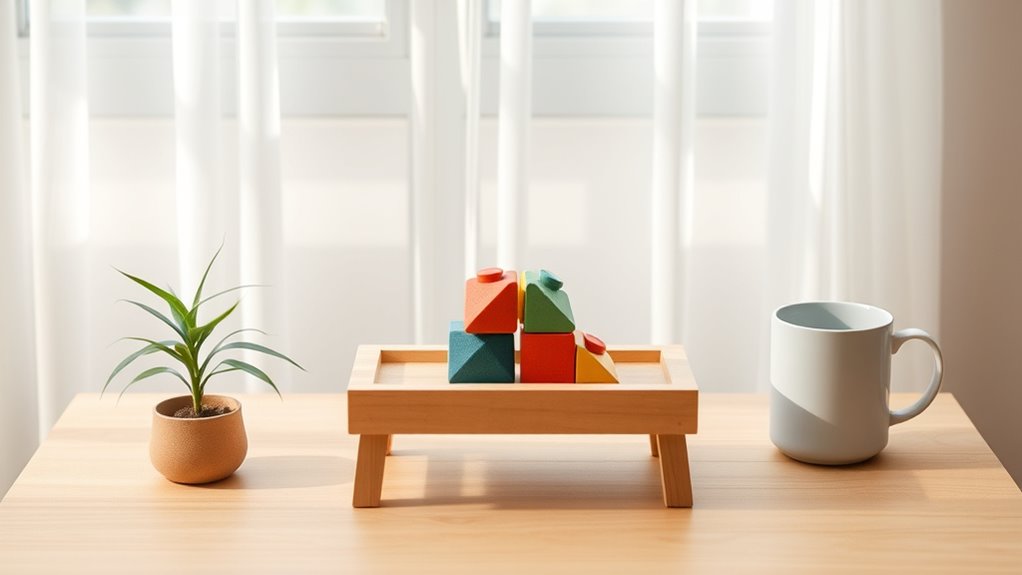
Implementing minimalist gift-giving traditions requires setting clear boundaries and communicating expectations with family and friends. You need to establish guidelines, like limiting gifts to 5–8 per occasion or using “two you want, one you need” rules. Encourage group gifting for meaningful experiences instead of multiple small items, and suggest monetary contributions toward shared gifts or activities. To deepen the practice, consider these strategies:
Set clear gift limits, promote shared experiences, and communicate mindful boundaries to foster meaningful giving.
- Define a manageable gift quantity per event
- Promote experiential gifts like memberships or outings
- Use reusable or biodegradable wrapping materials
- Adjust holiday traditions to focus on time and stories
- Educate children on mindful consumption and delayed gratification
- Recognize that setting these boundaries can help reduce holiday stress and financial strain, making the season more joyful and intentional. Boundaries are essential for fostering a more mindful gift culture. Clear communication and consistent boundaries help foster a more intentional gift culture, reducing clutter and emphasizing meaningful connections over material excess.
Age-Appropriate, Skill-Enhancing Gift Ideas
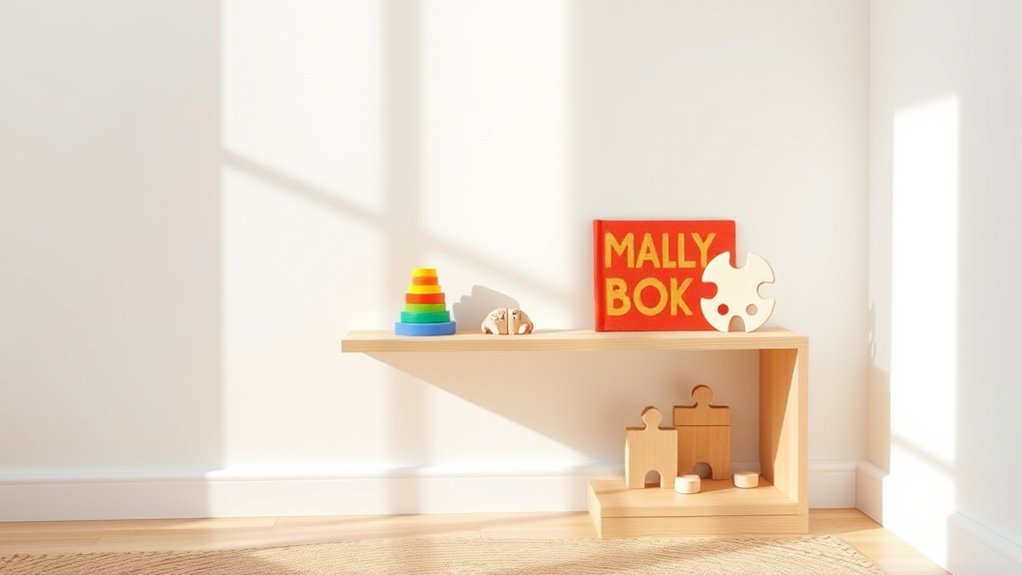
Choosing gifts that match a child’s age and developmental stage guarantees they’re both engaging and beneficial. For infants, sensory toys like soft blocks and nesting toys enhance hand-eye coordination, while pretend play items like baby dolls boost imagination. Large balls and push toys help strengthen big muscles, and simple board books support visual recognition. Music recordings with easy songs stimulate auditory senses. For toddlers, ride-on toys and building blocks develop gross and fine motor skills, while art supplies encourage creativity. Pretend play sets foster role-playing, and sensory activities like tunnels promote exploration. Engaging toys that support early communication such as sound-making toys and picture cards enhance language development. As kids grow into preschoolers, focus on gross motor toys such as balls and car ramps, along with puzzles and group toys that nurture social skills. Tailoring gifts to their age accelerates skill development while keeping play fun.
Fostering Long-Term Interests With Subscriptions and Courses
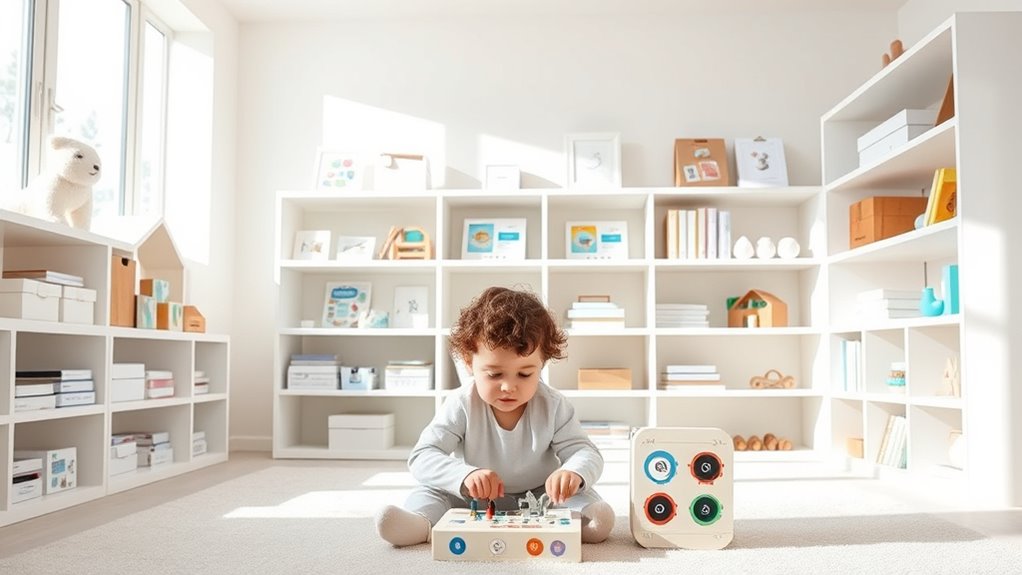
Fostering long-term interests in children can be effectively achieved through subscriptions and courses that provide ongoing, engaging learning experiences. These tools keep kids curious and motivated over time, turning their interests into lifelong skills. Subscription boxes like KiwiCo and Green Kid Crafts offer hands-on projects in STEM, arts, and crafts, catering to different age groups. Courses, especially online, add flexibility and depth, helping children develop specialized skills while maintaining their enthusiasm. To deepen engagement, consider options that adapt to your child’s evolving interests and include personalized content. The market is growing, driven by demand for creative, educational, and accessible experiences. With continuous innovation, these subscriptions and courses can nurture a child’s passion and build a foundation for future learning.
Subscriptions and courses nurture children’s long-term interests through engaging, personalized, and evolving learning experiences that foster lifelong skills.
- Focus on age-specific, interest-driven content
- Incorporate digital and hands-on activities
- Offer personalized experiences for sustained engagement
- Expand into developing economies for broader reach
- Balance quality with affordability for long-term retention
Frequently Asked Questions
How Can I Introduce My Child to Minimalist Gift-Giving Effectively?
To introduce your child to minimalist gift-giving, start by explaining the value of meaningful presents over many toys. Involve them in choosing quality items like books or art supplies that foster creativity. Teach them to appreciate experiences and simple gifts, like handmade notes or shared activities. Set an example by limiting your own gift-giving and emphasizing thoughtful giving, so they understand that quality and intention matter more than quantity.
What Are Some Ways to Encourage Independence Through Minimalist Gifts?
To encourage independence through minimalist gifts, focus on giving experiences, responsibilities, and tools that promote self-sufficiency. Offer your child meaningful activities like chores, cooking kits, or creative projects that teach life skills. Let them make choices about their possessions, fostering decision-making and ownership. By emphasizing practical gifts that require effort and engagement, you help build confidence, responsibility, and independence in a natural, supportive way.
How Do I Choose Age-Appropriate Open-Ended Toys for My Child?
Did you know that research shows children often enjoy toys more when they can explore and create freely? To choose age-appropriate open-ended toys, observe your child’s interests and play style. Select materials they feel comfortable with, like blocks or playdough, and display them invitingly. Focus on toys that promote sensory, physical, and imaginative play, ensuring they match your child’s developmental stage and foster their creativity and problem-solving skills.
What Are Some Sustainable Options for Craft and Art Supplies?
When choosing sustainable craft and art supplies, you can look for options made from recycled, biodegradable, or natural materials. Opt for non-toxic paints, crayons, and glues that are safe for kids. Consider upcycling household items for DIY projects, and choose brands committed to eco-friendly practices. These choices not only foster creativity but also teach children about environmental responsibility, making craft time both fun and mindful of the planet.
How Can Experiences Complement or Replace Traditional Gift Ideas?
Think of experiences as seeds you plant for lasting joy. They can easily replace traditional gifts by creating memories instead of clutter. You can give your child opportunities to explore new hobbies, attend shows, or go on trips, fostering skill development and emotional growth. These gifts strengthen bonds and provide ongoing happiness, making them a meaningful alternative to material presents. Plus, they support a minimalist lifestyle by focusing on what truly matters.
Conclusion
By choosing minimalist gifts that prioritize skill-building over clutter, you’re not just giving a present—you’re opening a universe of endless creativity and lifelong learning for your child. These gifts nurture their potential like a master sculptor shaping a masterpiece, transforming ordinary moments into extraordinary memories. Embrace the art of thoughtful giving, and watch as your child’s curiosity and skills flourish into something truly magnificent—far beyond what any pile of stuff could ever achieve.
I’m Theodore, and I love tiny houses. In fact, I’m the author of Tiny House 43, a book about tiny houses that are also tree houses. I think they’re magical places where imaginations can run wild and adventures are just waiting to happen.
While tree houses are often associated with childhood, they can be the perfect adult retreat. They offer a cozy space to relax and unwind, surrounded by nature. And since they’re typically built on stilts or raised platforms, they offer stunning views that traditional homes simply can’t match.
If you’re looking for a unique and romantic getaway, a tree house tiny house might just be the perfect option.
